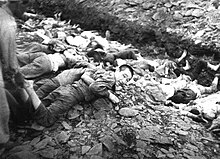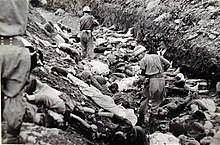Bodo League massacre
| Bodo League massacre | |
|---|---|
 Summary execution of South Korean political prisoners by the South Korean military and police at Daejeon, South Korea. | |
| Location | Korea |
| Date | summer of 1950 |
| Target | Communist sympathizers |
Attack type | Massacre |
| Deaths | 100,000-1,200,000[1] |
| Perpetrators | Syngman Rhee anticommunist forces |
| Motive | Fear of a North Korean Fifth column |
The Bodo League massacre (Korean: 보도연맹 사건, Hanja: 保導聯盟事件) was a massacre of alleged communists and suspected sympathizers that occurred in the summer of 1950 during the Korean War. Estimates of the death toll vary. According to Prof. Kim Dong-Choon, Commissioner of the Truth and Reconciliation Commission, at least 100,000 people were executed on suspicion of supporting communism.[2] Historians believe up to 200,000 were killed by the United Nations-allied South Korean military and South Korean Police.[3] South Korean civilian organizations believe there might have been up to 1,200,000 victims.[1] The massacres were blamed on the communists for decades.[4]
Bodo League
In the run up to the Korean War the first president of South Korea, Syngman Rhee, had about 30,000 alleged communists in his jails, and had about 300,000 suspected sympathizers enrolled in an official "re-education" movement known as the Bodo League (or National Rehabilitation and Guidance League, National Guard Alliance,[6] National Bodo League,[7] Bodo Yeonmaeng,[6] Gukmin Bodo Ryeonmaeng, 국민보도연맹, 國民保導聯盟) on the pretext of protecting them from execution.[4][6] There were also non-communist sympathizer people who were forced into the Bodo League to fill the enlistment quota.[7]
In June 1949, the South Korean government accused independence activists of being members of the Bodo League and arrested them.[6]
Executions


Kim Il-sung's communist army attacked from the North in June 1950, starting the Korean War.[9] According to Kim Mansik who was a military police superior officer, President Syngman Rhee ordered the execution of Bodo League and South Korean Workers Party related people on 27 June,[10][11] the first massacre was started in Hoengseong, Gangwon-do on 28 June.[11][12] Retreating South Korean forces and anti communist groups[13] executed the alleged-communist prisoners, along with many of the Bodo League members.[4] The executions were without any trials.[14]
United States official documents show American officers witnessed and photographed the massacre.[14] In one case a US officer is known to have sanctioned the killing of political prisoners to avoid their coming into enemy hands.[15][4] On the other hand, United States official document showed that John Muccio, then United States Ambassador to South Korea, recommended South Korean President Rhee Syngman and Defense Minister Shin Sung-mo to stop the executions.[14] The massacre was also reported to both Washington and General Douglas MacArthur.[4] The British troops seized one execution site to prevent further massacres there.[16] There were British and Australian witnesses also.[4][5] American witnesses also saw the scene of 12- or 13-year old girls' executions.[14]
South Korean Retired Admiral Nam Sang-hui confessed that the victims bodies were thrown into the sea.[14]
Truth and Reconciliation Commission
Discoveries in 2008 in Daejon, South Korea (among other sites) of trenches containing executed children,[15] leftist civilians and communist sympathizers have opened a chapter of South Korean history unknown to most South Korean civilians.[8] South Korea's Truth and Reconciliation Commission documented testimonies of those still alive and who took part in the executions, including former Daejon prison guard Lee Joon-young. Reports were also released in various articles that General Douglas MacArthur called the executions "An internal South Korean matter" at that time.[15]
Besides photographs of the execution trench sites, the National Archives in Washington D.C. released declassified photographs of U.S. soldiers at execution sites including Daejon, confirming American military knowledge.[15]
See also
References
- ^ a b "More than 600,000, less than 1,200,000! 최소 60만명, 최대 120만명!". The Hankyoreh Plus. 2001-06-20. Retrieved 21 December 2008.Template:Ko icon
- ^ "Khiem and Kim Sung-soo: Crime, Concealment and South Korea". Japan Focus. Retrieved 11 August 2008.
- ^ Charles J. Hanley & Hyung-Jin Kim (July 10, 2010). "Korea bloodbath probe ends; US escapes much blame". Associated Press. San Diego Union Tribune. Retrieved May 23, 2011.
- ^ a b c d e f "South Korea owns up to brutal past". The Sydney Morning Herald. 2007. Retrieved 2008-12-15.
- ^ a b "Truth commission confirms Korean War killings by soldiers and police 3,400 civilians and inmates were shot dead or drowned out of concerns they might cooperate with the People's Army". Hankyoreh. 2009-03-03. Retrieved 2010-07-13.
- ^ a b c d "Family tragedy indicative of S. Korea's remaining war wounds — Kim Gwang-ho is waiting for the government to apologize for state crimes committed against his father and grandfather". Hankyoreh. 2010-01-23. Retrieved 2010-07-22.
- ^ a b "Waiting for the truth — A missed deadline contributes to a lost history". Hankyoreh. 2007-06-25. Retrieved 2010-07-22.
- ^ a b c Charles J. Hanley & Hyung-Jin Kim (10 July 2010). "Korea bloodbath probe ends; US escapes much blame". Associated Press. San Diego Union Tribune. Retrieved 2011-05-23.
- ^ Stokesbury, James L (1990). A Short History of the Korean War. New York: Harper Perennial. ISBN 0688095135.
- ^ "60년 만에 만나는 한국의 신들러들". Hankyoreh (in Korean). 2010-06-25. Retrieved 2010-07-14.
- ^ a b ""보도연맹 학살은 이승만 특명에 의한 것" 민간인 처형 집행했던 헌병대 간부 최초증언 출처 : "보도연맹 학살은 이승만 특명에 의한 것" - 오마이뉴스". Ohmynews (in Korean). 2007-07-04. Retrieved 2010-07-14.
- ^ "헌병대의 보도연맹원 '대량학살' 최초 구체증언 확보 6.25 당시 헌병대 과장 김만식 씨 증언 토대, 전국 조직적 학살 자행". CBS (in Korean). 2007-07-04. Retrieved 2010-07-14.
- ^ Kim Young Sik (2003-11-17). "The left-right confrontation in Korea – Its origin". asianresearch.org. Retrieved 2008-12-15.
- ^ a b c d e "New evidence of Korean war killings". BBC. 2000-04-21. Retrieved 2010-07-23.
- ^ a b c d Charles J. Hanley and Jae-soon Chang (December 6, 2008). "Children 'executed' in 1950 South Korean killings". Associated Press. Breitbart. Retrieved December 15, 2008.
- ^ "Unearthing proof of Korea killings". BBC. 2008-08-18. Retrieved 2010-07-23.
External links
- Mass Killings in Korea — Commission Probes Hidden History of 1950, Associated Press (Video and Documents)
- Unearthing War’s Horrors Years Later in South Korea, New York Times, December 3, 2007.
- TRCK confirms hundreds of villagers were massacred during onset of Korean War The commission advises an official state apology and will continue investigations of the National Guard Alliance through the end of the year, Hankyoreh, Nov. 17, 2009.
- Truth commission confirms Korean War killings by soldiers and police 3,400 civilians and inmates were shot dead or drowned out of concerns they might cooperate with the People’s Army, Hankyoreh, Mar. 3, 2009.
- Template:Ko icon 헌병대의 보도연맹원 '대량학살' 최초 구체증언 확보, Nocut News (CBS), 2007-07-04.
- Template:Ko icon "왜, 어떻게 죽었는지라도 알고 싶다", OhmyNews, 2007-07-02.
- Photograhies Photograhies of the wailing victimes at truck They were transported by trucks to an execution ground.
